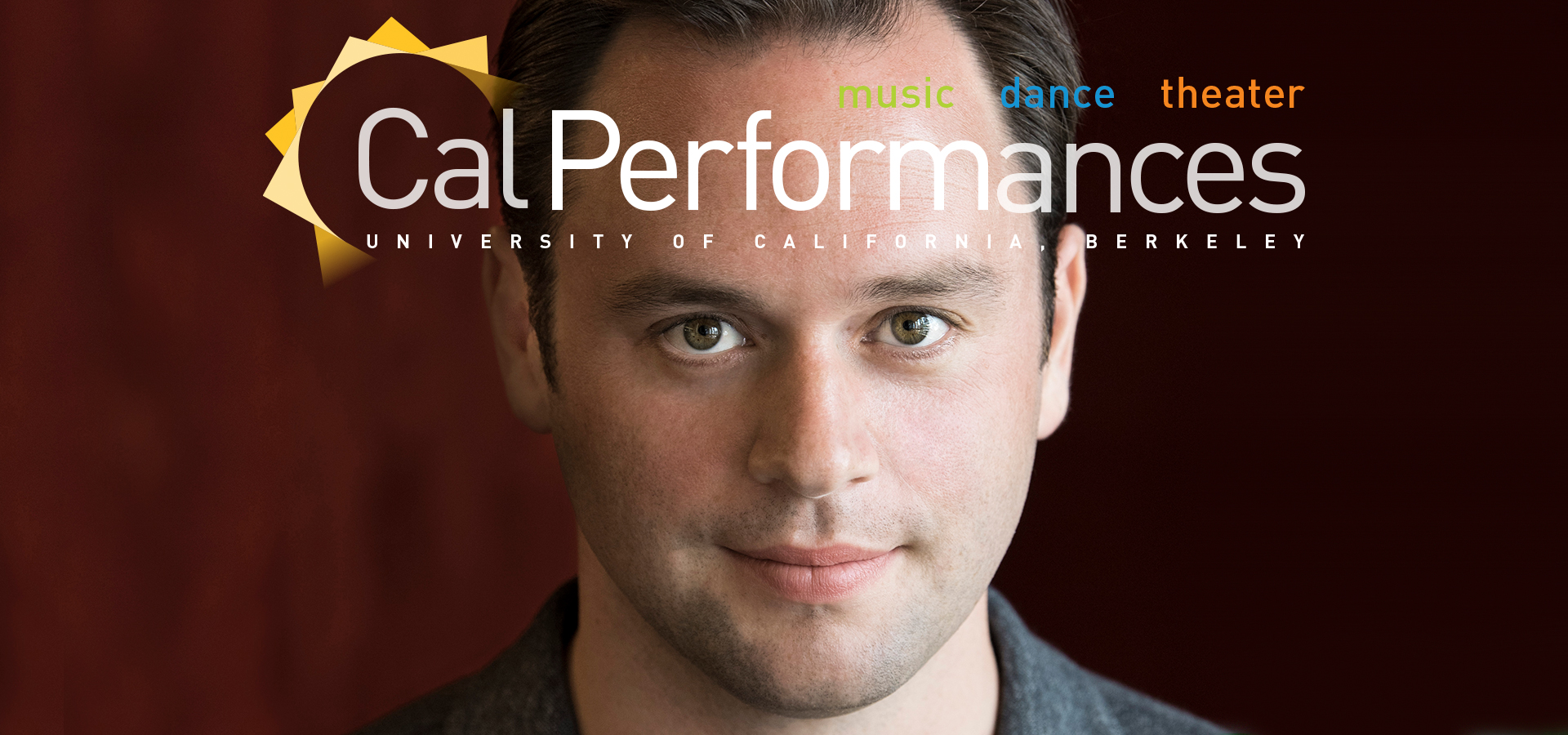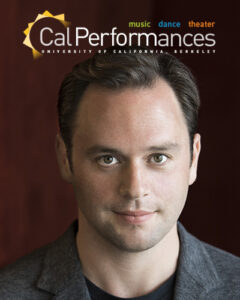Paul Appleby, tenor
Conor Hanick, piano
Sunday, January 30, 2022
Hertz Hall
From the Executive and Artistic Director

January marks not only the beginning of a brand new year, but also the return of Cal Performances at Home programming to our schedule. Last year, when Covid-19 shutdowns forced the cancellation of our entire 2020–21 season, this ambitious new program was extraordinarily successful in forging connections with the performing arts during some of the darkest days of the pandemic, with more than two dozen professionally produced performance videos streamed directly to audiences all over the world. For many, Cal Performances at Home provided their only meaningful contact with music, dance, and theater events. (These programs require additional investment beyond our live performance-producing efforts, for which we have received some sponsorship. If you’re moved to donate in support of digital programming, it would be greatly appreciated.)
This month’s schedule features three newly produced Cal Performances at Home programs—with the Danish String Quartet (streaming Jan 13–19), Caleb Teicher & Company (Jan 20–26), and the Kronos Quartet with special guest Mahsa Vahdat (Jan 27–Feb 2)—streamed live and free of charge to your home. And on January 30, Cal Performances returns to Hertz Hall for the first time since the beginning of the pandemic for an eagerly awaited program of lieder by Beethoven, Schubert, Schumann, and Berg with tenor Paul Appleby with pianist Conor Hanick.
Looking forward, the rest of our season is similarly packed with the kind of adventurous and ambitious programming you’ve come to expect from Cal Performances. You won’t want to miss…
- the ever-popular Les Ballet Trockadero de Monte Carlo (Feb 4–5); Joffrey Ballet (Mar 4–6); and Alvin Ailey American Dance Company (Mar 29 – April 3)
- jazz legend Wayne Shorter and the brilliant esperanza spalding with their thrilling new opera …(Iphigenia) (Feb 12)
- early-music masters Jordi Savall and Le Concert des Nations (Mar 4) and the English Baroque Soloists with conductor Sir John Eliot Gardiner (Apr 10)
- the peerless London Symphony Orchestra, appearing under the direction of superstar conductor Simon Rattle (Mar 20)
- pianist extraordinaire Mitsuko Uchida with the Mahler Chamber Orchestra (Mar 27)
- our brilliant 2021–22 artist-in-residence Angélique Kidjo in her exciting new music-theater piece Yemandja (a highly anticipated Cal Performances co-commission, Apr 23)
And so much more… with dozens of performances by the world’s finest music, dance, and theater artists, stretching into May. In particular, I want to direct your attention to this year’s Illuminations: “Place and Displacement” programming, through which we’ll explore both loss and renewal, disempowerment and hope, while seeking paths forward for reclaiming and celebrating vital cultural connections that can fall victim to political and social upheaval.
We’re very proud of our new and updated winter brochure and know that a few minutes spent reviewing our schedule—there or online—will reveal of wealth of options for your calendar; now is the perfect time to guarantee that you have the best seats for all the events you plan to attend.
I know you join us in looking forward to what lies ahead, to coming together once again to encounter the life-changing experiences that only the live performing arts deliver. We can’t wait to share it all with you during the coming months.
Cal Performances is back. Happy New Year, and welcome home!
Jeremy Geffen
Executive and Artistic Director, Cal Performances
 January marks not only the beginning of a brand new year, but also the return of Cal Performances at Home programming to our schedule. Last year, when Covid-19 shutdowns forced the cancellation of our entire 2020–21 season, this ambitious new program was extraordinarily successful in forging connections with the performing arts during some of the darkest days of the pandemic, with more than two dozen professionally produced performance videos streamed directly to audiences all over the world. For many, Cal Performances at Home provided their only meaningful contact with music, dance, and theater events. (These programs require additional investment beyond our live performance-producing efforts, for which we have received some sponsorship. If you’re moved to donate in support of digital programming, it would be greatly appreciated.)
January marks not only the beginning of a brand new year, but also the return of Cal Performances at Home programming to our schedule. Last year, when Covid-19 shutdowns forced the cancellation of our entire 2020–21 season, this ambitious new program was extraordinarily successful in forging connections with the performing arts during some of the darkest days of the pandemic, with more than two dozen professionally produced performance videos streamed directly to audiences all over the world. For many, Cal Performances at Home provided their only meaningful contact with music, dance, and theater events. (These programs require additional investment beyond our live performance-producing efforts, for which we have received some sponsorship. If you’re moved to donate in support of digital programming, it would be greatly appreciated.)
This month’s schedule features three newly produced Cal Performances at Home programs—with the Danish String Quartet (streaming Jan 13–19), Caleb Teicher & Company (Jan 20–26), and the Kronos Quartet with special guest Mahsa Vahdat (Jan 27–Feb 2)—streamed live and free of charge to your home. And on January 30, Cal Performances returns to Hertz Hall for the first time since the beginning of the pandemic for an eagerly awaited program of lieder by Beethoven, Schubert, Schumann, and Berg with tenor Paul Appleby with pianist Conor Hanick.
Looking forward, the rest of our season is similarly packed with the kind of adventurous and ambitious programming you’ve come to expect from Cal Performances. You won’t want to miss…
- the ever-popular Les Ballet Trockadero de Monte Carlo (Feb 4–5); Joffrey Ballet (Mar 4–6); and Alvin Ailey American Dance Company (Mar 29 – April 3)
- jazz legend Wayne Shorter and the brilliant esperanza spalding with their thrilling new opera …(Iphigenia) (Feb 12)
- early-music masters Jordi Savall and Le Concert des Nations (Mar 4) and the English Baroque Soloists with conductor Sir John Eliot Gardiner (Apr 10)
- the peerless London Symphony Orchestra, appearing under the direction of superstar conductor Simon Rattle (Mar 20)
- pianist extraordinaire Mitsuko Uchida with the Mahler Chamber Orchestra (Mar 27)
- our brilliant 2021–22 artist-in-residence Angélique Kidjo in her exciting new music-theater piece Yemandja (a highly anticipated Cal Performances co-commission, Apr 23)
And so much more… with dozens of performances by the world’s finest music, dance, and theater artists, stretching into May. In particular, I want to direct your attention to this year’s Illuminations: “Place and Displacement” programming, through which we’ll explore both loss and renewal, disempowerment and hope, while seeking paths forward for reclaiming and celebrating vital cultural connections that can fall victim to political and social upheaval.
We’re very proud of our new and updated winter brochure and know that a few minutes spent reviewing our schedule—there or online—will reveal of wealth of options for your calendar; now is the perfect time to guarantee that you have the best seats for all the events you plan to attend.
I know you join us in looking forward to what lies ahead, to coming together once again to encounter the life-changing experiences that only the live performing arts deliver. We can’t wait to share it all with you during the coming months.
Cal Performances is back. Happy New Year, and welcome home!
Jeremy Geffen
Executive and Artistic Director, Cal Performances





